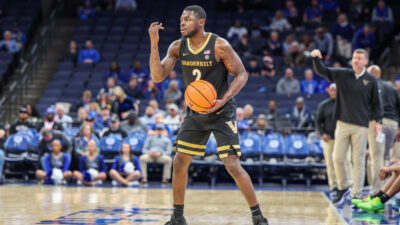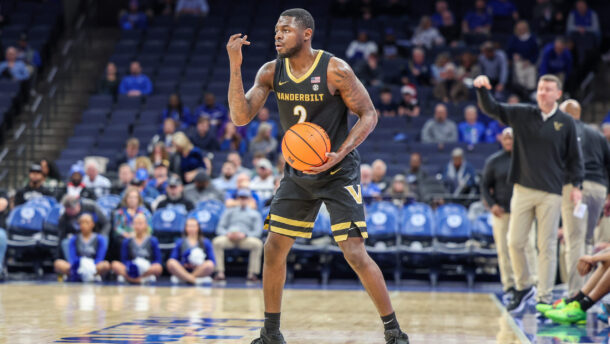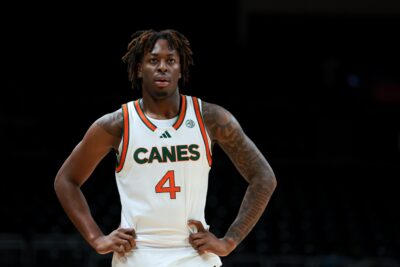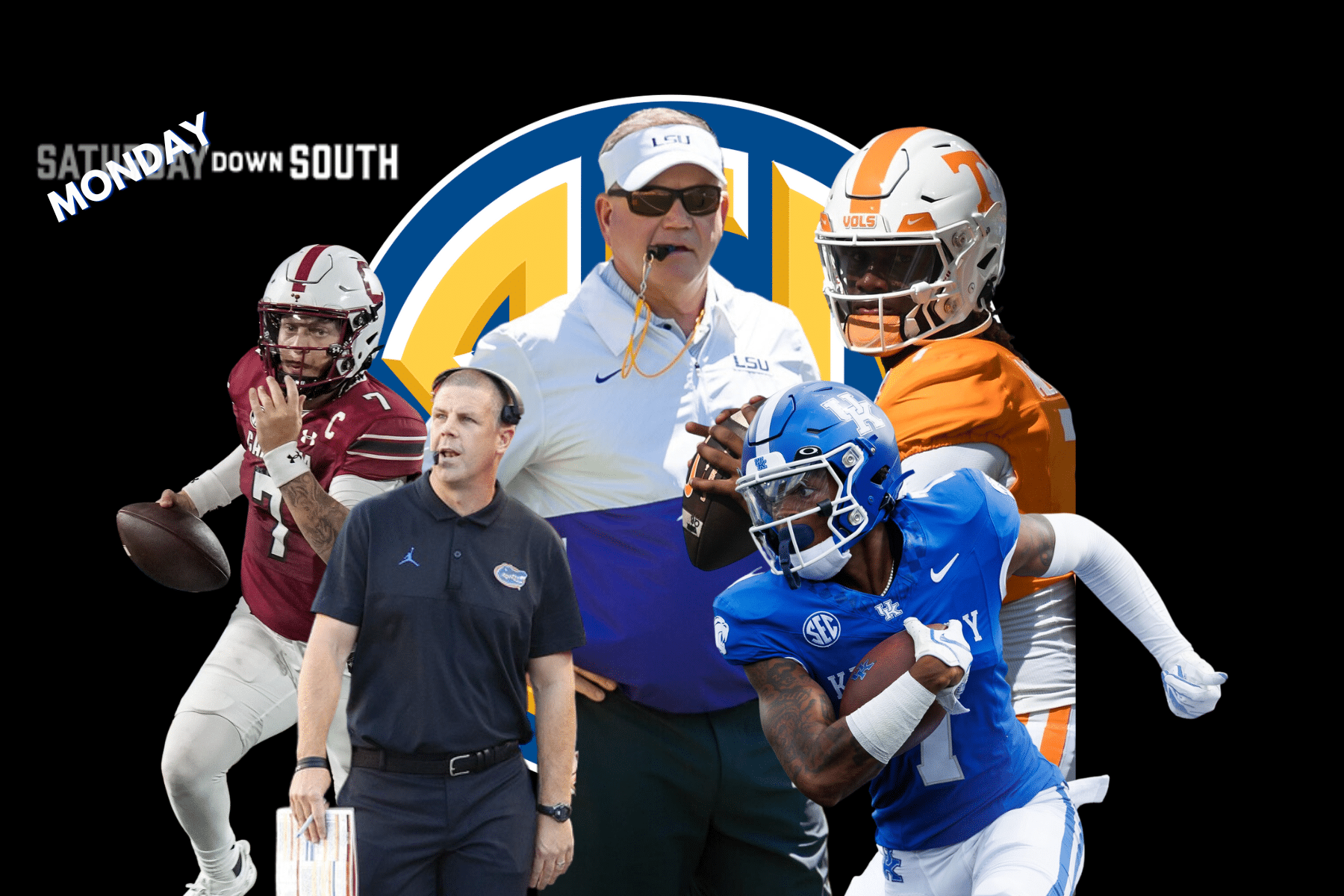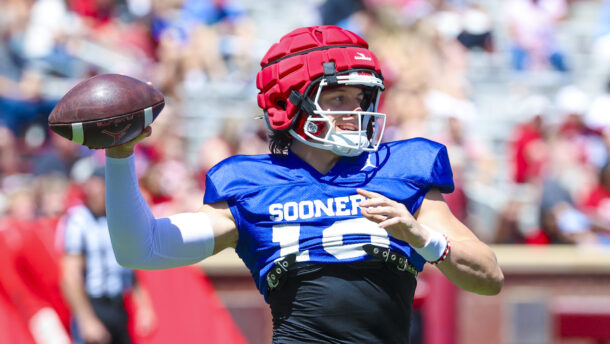
What to expect from Oklahoma QB John Mateer in his first SEC season
John Mateer may be the most interesting quarterback in the SEC entering the 2025 season. Even though he’s hardly played a down East of the Rocky Mountains, Mateer’s arrival in the SEC has been noted far and wide. He’s appeared on various top-10 QB lists, is regarded as perhaps the best transfer QB of the cycle and now is at the center of what might be Brent Venables’ last chance to succeed in Norman.
At Washington State, Mateer was efficient. He was asked to make quick decisions and float deep passes with excellent touch — something he shined at. He was powerful and skilled in the run game, too, rushing for over 800 yards and 15 touchdowns.
But when fans think back on Mateer’s college career years from now, most outside of Pullman will only think about what he was able to accomplish in Norman — about what he could do in the SEC where the linebackers are bigger, the cornerbacks are longer and the opposing coordinators are smarter.
Setting expectations for John Mateer at Oklahoma
If you’re interested in what historical precedent says about Mateer’s outlook, you’ve come to the right place. Since 2014, there have been 4 quarterbacks to make the move from a Group-of-5 program to the SEC (while throwing at least 200 passes in a season at each stop). Here’s the list: Collin Hill, Riley Neal, Diego Pavia and Taylen Green.
That’s not much of a sample size to draw on, but we can still find some takeaways. The chart below shows the passer efficiency rating for each of the quarterbacks mentioned above in their final Group-of-5 seasons followed by their first SEC campaign. As you can see, progress (or lack thereof) is relatively flat. Hill and Pavia both suffered slight decreases in their efficiency while Neal and Green each had a similarly-sized uptick.
Other QBs who have made the Group-of-5 to SEC transition
Despite the step up in competition, all new teammates, coaches and environments, each of the 4 quarterbacks above were able to make the transition to the SEC while maintaining essentially the same passer efficiency rating they held at lower levels.
If that trend holds, it’s excellent news for Oklahoma. Mateer posted a passer efficiency rating of 164.1 last season, which ranked 8th among qualified quarterbacks last season. Now, a 164 passer rating does not make Mateer a world-beater. It’s still a far cry from the record-destroying numbers that Baker Mayfield and Kyler Murray were putting up in Norman just a few years ago. But considering where this Oklahoma offense was in 2024, it would be a welcomed and celebrated improvement. Last season, the Sooners combined for a passer rating of 125.42. Considering Oklahoma still managed to play some close games last season, it’s not an exaggeration to think it could have won 2 additional games with Mateer-level QB play.
There’s another stat I want to talk about with regards to Mateer: dead-end throw rate. This is a stat I’ve been working with this offseason. Dead-end throw rate is simply this: How often do you throw an incomplete pass or a completion for 4 yards or less? The stat tracks very well with passer efficiency rating despite not including anything about yardage, touchdowns or interceptions. It’s a measure of how wasteful a quarterback is while filtering out the noisy plays that can inflate or deflate a quarterback’s efficiency over a handful of games. Earlier this offseason, I used dead-end throw rate to evaluate Nico Iamaleava and Jackson Arnold.
Now on to Mateer. Last season, he had a dead-end throw rate of just 44.96%. That is very good. It ranked 6th out of all qualified (min. 200 attempts) passers at the FBS level last season. For context, Indiana’s Kurtis Rourke led the nation in this stat at 39.38% last year. Joe Burrow in 2019 has the CFP-era record among P5 quarterbacks at just over 35%.
Now for the really good news if you’re an Oklahoma fan: Mateer arrives in Norman alongside his offensive coordinator in Ben Arbuckle. That means Arbuckle will, at least in theory, have a leg up on some of his predecessors with regards to the G5-to-SEC move. That’s because dead-end throw rate doesn’t just approximate quarterback efficiency — it also says something about the pieces around the quarterback, particularly your offensive coordinator. How good is your coordinator at scheming receivers open? How often do you have to resort to check-downs?
Arbuckle has a history of producing quarterbacks with a good dead-end throw rate. He previously served as the offensive coordinator at Western Kentucky (2022) and Washington State (2023). Here’s a chart looking at his previous primary quarterbacks and their DETR production for those seasons:
Obviously Arbuckle has had a good group of quarterbacks so far in his career. Reed was a well-above-average G5 quarterback and Arbuckle also coached Cam Ward the year before he became a Heisman Trophy finalist. Reed’s DETR is below average, but the numbers for Ward and Mateer are good-to-great. Most importantly, it’s impressive that Arbuckle, 29, has been able to guide quarterbacks to this level of down-to-down consistency so early in his coaching career. He’s clearly trending up in that regard, too.
What about Mateer’s running chops?
A significant part of Mateer’s statistical profile is what he does on the ground. Last season at Washington State, he rushed for 826 yards on an impressive 178 attempts. The efficiency there is almost as important as the volume. Mateer regularly turned to his legs in order to get first downs. He picked up 57 first downs on the ground last season, which was 4th in the nation among quarterbacks. He was only behind two triple-option quarterbacks and New Mexico’s Devon Dampier in that regard.
Whether they were designed runs or scramble situations, Mateer ran on late downs last season more than almost any quarterback in the country. His 61 rush attempts on 3rd or 4th down was 2nd-most among quarterbacks only to Army’s Bryson Daily. About half of those runs came with more than 4 yards to gain, so he wasn’t afraid to use his legs in passing situations either. However, his success rate on those runs was about 23% — not good. Optimizing his ground game on those key downs will be pivotal for Mateer in Norman.
I also wonder what Mateer’s rushing volume will look like in a more-bruising SEC. There have only been 12 seasons since the turn of the century in which an SEC quarterback has amassed 175 rushing attempts. Three of them belong to Tim Tebow. Jayden Daniels, Jalen Hurts, Dak Prescott, Johnny Manziel and Cam Newton are a few of the other names on the list. But so is another name that was mentioned earlier: Diego Pavia. His rushing attempts at Vandy actually increased pretty significantly but his efficiency dropped by about a full yard per carry compared to his final season at New Mexico State.
Some of that — maybe a lot of it — was related to Vandy’s OL struggles. If Oklahoma can be better up front next season, which it should be, then perhaps Mateer can avoid following in Pavia’s footsteps. In any case, it’s a thin line for Mateer and Arbuckle to walk. How can they use Mateer’s legs as a dimension of the offense while also preserving his health? History would say it’s difficult to be a high-volume rusher in the SEC as a quarterback unless you’re one of the best athletes in the sport. Outside of inner-circle SEC Football Hall-of-Famers (if such a thing existed), the only QBs to accomplish that feat over the last quarter-century are Chris Relf and Nick Fitzgerald (twice).
So what’s a fair expectation for Mateer in 2025? It’s a bit complicated. Oklahoma still has more than its fair share of injury issues at wide receiver. If Deion Burks misses time again, Oklahoma will be without a true No. 1 option at receiver. Questions remain at offensive line and tight end as well, although the Sooners are expected to be better in those areas — if not significantly better — than they were a year ago. If the supporting cast is at least average (by SEC standards) I think you’ll see Mateer put up quality efficiency numbers as a passer. I’m less sure about his rushing production being able to carry over against SEC defenses — in either volume or efficiency.
At BetMGM, Mateer’s Heisman Trophy odds are listed at +2500. That price seems like a fair one to me, although a lot would have to go right in order for Mateer to find himself in New York City this December. For a long time, a successful Oklahoma quarterback season could only end in the Big Apple. That’s not where OU is at this point in time. Even if Mateer falls short of the standard set by Mayfield, Murray, Hurts and others, there’s still plenty of room for progress to be made. Significant, meaningful progress is well within reach and should be the goal for both Mateer and Venables in 2025.
Spenser is a news editor for Saturday Down South and covers college football across all Saturday Football brands.


